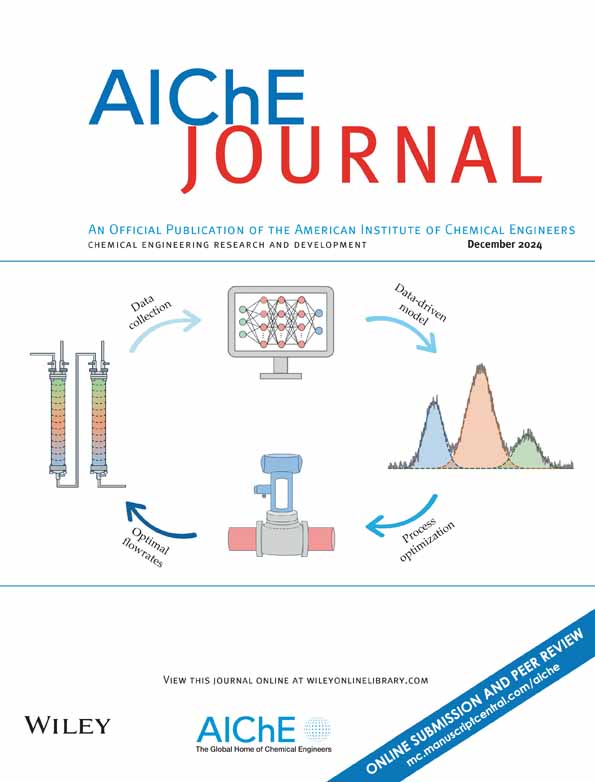Dual-reaction pathway engineering via anode-driven methanol oxidation for efficient electrocatalytic ammonia production
IF 3.5
3区 工程技术
Q2 ENGINEERING, CHEMICAL
引用次数: 0
Abstract
Replacing the anodic oxygen evolution reaction with selective methanol oxidation to formic acid offers a promising route to enhance paired electrochemical ammonia synthesis. However, the inherent kinetic and thermodynamic disparities between the cathodic reduction reaction and anodic oxidation reaction present significant challenges in achieving optimal electrochemical system performance. Herein, we propose a dual-reaction strategy employing bifunctional Au/CoOOH nanocomposite catalysts, achieving simultaneous NH3 production (34.15 g) and formic acid synthesis (69.65 g) after 24 h at 2.6 V cell voltage. Density functional theory (DFT) calculations further reveal that loading in Co-based catalysts and its hybridization with Au nanoparticles can effectively tune the electronic configuration of the Co-O sites to poison their strong adsorption capacity of intermediate products, lowering the reaction energy barrier to alter the reaction pathway. This work provides an atomic-level design principle for coupled electrochemical systems, demonstrating better reaction efficiency, while co-producing high-value chemicals for scalable green ammonia synthesis.通过阳极驱动甲醇氧化实现双反应途径工程,从而实现高效电催化合成氨生产
用选择性甲醇氧化制甲酸取代阳极析氧反应,为加强配对电化学合成氨提供了一条很有前途的途径。然而,阴极还原反应和阳极氧化反应之间固有的动力学和热力学差异给实现最佳电化学系统性能带来了重大挑战。在此,我们提出了一种双功能Au/CoOOH纳米复合催化剂的双反应策略,在2.6 V电池电压下,在24 h后同时生成NH3 (34.15 g)和甲酸(69.65 g)。密度泛函理论(DFT)计算进一步表明,co基催化剂的负载及其与Au纳米粒子的杂化可以有效地调整Co-O位点的电子构型,从而削弱其对中间产物的强吸附能力,降低反应能垒,从而改变反应途径。这项工作为耦合电化学系统提供了一个原子水平的设计原则,展示了更好的反应效率,同时为可扩展的绿色氨合成共同生产高价值化学品。
本文章由计算机程序翻译,如有差异,请以英文原文为准。
求助全文
约1分钟内获得全文
求助全文
来源期刊

AIChE Journal
工程技术-工程:化工
CiteScore
7.10
自引率
10.80%
发文量
411
审稿时长
3.6 months
期刊介绍:
The AIChE Journal is the premier research monthly in chemical engineering and related fields. This peer-reviewed and broad-based journal reports on the most important and latest technological advances in core areas of chemical engineering as well as in other relevant engineering disciplines. To keep abreast with the progressive outlook of the profession, the Journal has been expanding the scope of its editorial contents to include such fast developing areas as biotechnology, electrochemical engineering, and environmental engineering.
The AIChE Journal is indeed the global communications vehicle for the world-renowned researchers to exchange top-notch research findings with one another. Subscribing to the AIChE Journal is like having immediate access to nine topical journals in the field.
Articles are categorized according to the following topical areas:
Biomolecular Engineering, Bioengineering, Biochemicals, Biofuels, and Food
Inorganic Materials: Synthesis and Processing
Particle Technology and Fluidization
Process Systems Engineering
Reaction Engineering, Kinetics and Catalysis
Separations: Materials, Devices and Processes
Soft Materials: Synthesis, Processing and Products
Thermodynamics and Molecular-Scale Phenomena
Transport Phenomena and Fluid Mechanics.
 求助内容:
求助内容: 应助结果提醒方式:
应助结果提醒方式:


